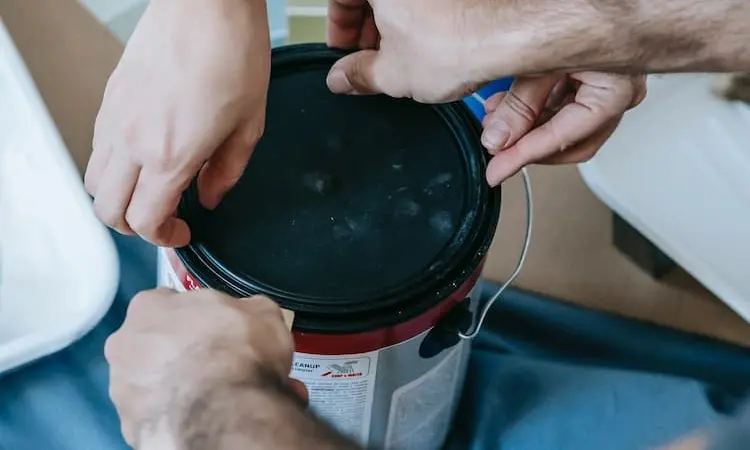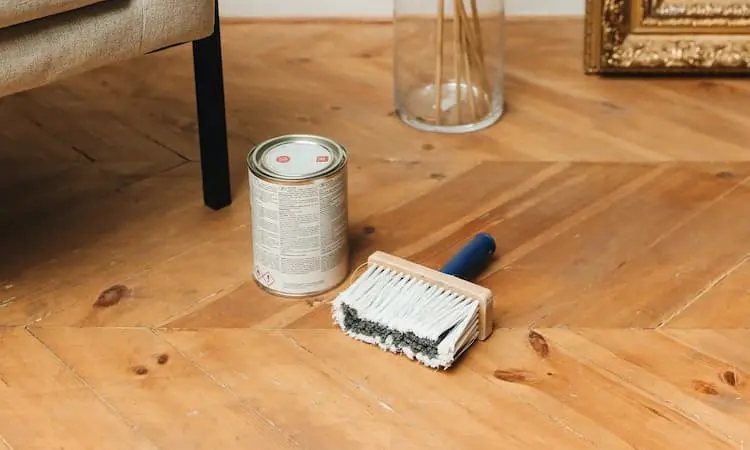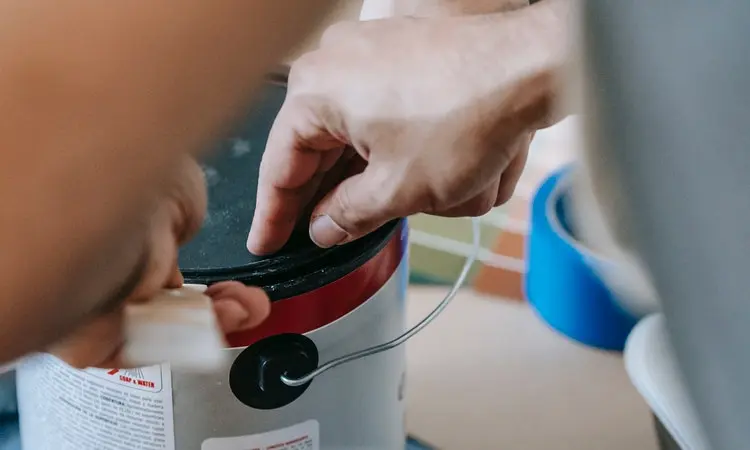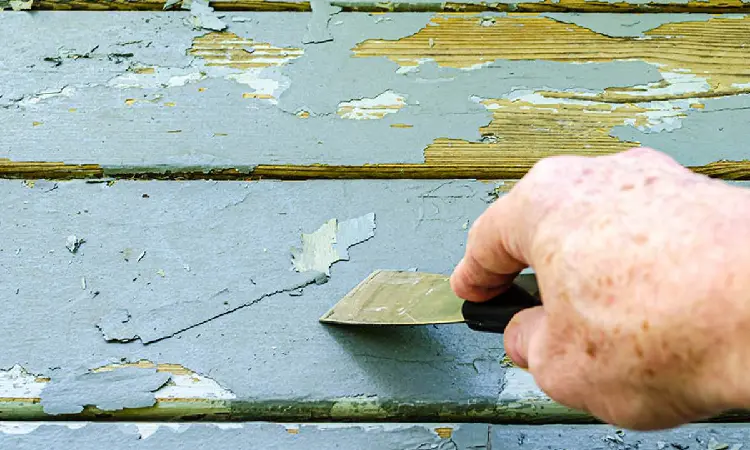House painting projects come in different shapes and sizes. For instance, one homeowner might decide to spruce up their kitchen by painting the cabinets.
Meanwhile, someone else may choose to cover the table and chairs with a coat of paint to do the same thing.
Regardless of what you’re doing, you need to take the time to research and pick the correct paint.
That will ensure you get the finish and look you were hoping for. Not to mention, if you select appropriately, the paint will hold up to wear and tear well.
Even still, scratches and blemishes can come about, so if you have leftover paint, you should keep it on hand.
But then how to store paint can become an issue. It doesn’t have to, though, thanks to these tips that will teach you to store paint in canning jars, plastic containers, and more.
Then, you’ll be able to pack the pieces up and put them away. Just be sure it’s somewhere that provides suitable conditions, typically found on paint labels.
However, I will be discussing factors like temperatures, best locations to store paint, and whatnot here. So, stay tuned to learn more.

How Long Is An Unopened Paint Good For?
The answer to how long is an unopened paint good for will vary, depending on who you ask. However, according to the
Glidden website, which is a paint brand manufactured by PPG Industries, the shelf life of the paint is two years.
Then, an article on the Bob Vila web page says water-based acrylic paints and latex paints can last up to 10 years.
As for alkyd and oil-based solutions, it states they have shelf lives of up to 15 years.
So, how long your paint lasts will depend on what you buy. The brand and type of paint can both determine how long your unopened containers will remain good.
If you have a question about something specific, a quick Google search can probably give you the answer.
Or, if you’re a people person, don’t hesitate to ask the store clerk. Selling paint is what they do, so they should have access to the information you desire.
Even if they don’t know the answer off the top of their head, they will have the resources to find it.
Perhaps they can pull up the manufacturer’s website to locate it, or there might be a catalog behind the desk with details.
Or, if all else fails, the employee could always ask their manager or a co-worker for the solution.
In one way or another, you should be able to find out how long unopened paint will remain good.
How Long is An Opened And Properly Stored Paint Good For?
Leftover paints, providing that you want to keep them on hand, must be stored in cool, dry places and away from freezing temperatures.
If you’re not interested in keeping the extra, just dispose of it correctly. But really, it could be in your best interest to hold onto it.
Imagine that you buy a new couch. Everything goes swimmingly getting it home, but once you arrive and start bringing it inside, you learn the hallway is a bit narrower than you thought.
The wooden legs put big scuffs and scrapes in the paint. Had you kept the leftover paint, you would now be able to touch things up, making the walls look good as new.
When paints are properly sealed and stored away, they usually last for several years before going bad.
Therefore, don’t merely throw the leftovers out. If you do that, you’ll have to buy a new can if something happens unless the manufacturer discontinues the color.
Then, you could be forced to repaint an entire room. Thus, do yourself a favor and properly store your used paint away.
Is it Safe To Store Paint In Your House?

Paint fumes can be toxic, especially to vulnerable groups such as pregnant women, the elderly, and young children.
However, as long as the paint is stored in an air-tight container, all should be fine.
In addition, you’ll want to put the cans or bottles in a place where little ones can’t get to them. Nobody needs them getting lids off and digesting the paint.
The primary concern with storing paint anywhere is ensuring the location does not get extremely humid, hot, or cold.
But where you store paint is up to you. Perhaps the garage is the best place, as it’s away from people, or the temperature might disagree.
Then again, the utility room, basement, or even a hallway closet could be a better fit. It just depends on your situation and your home’s layout.
Also, ensure there’s no spilled paint on the side of the containers. The last thing you need is a pet coming along and licking it up.
That could earn them a trip to the vet and one you’ll have to pay for. Plus, you don’t want the paint all over everything and causing damage.
So, be sure the lids of containers are on tight and wipe excess paint away to safely store latex, semi-gloss, or other paint products in the house.
What Is The Best Place To Store Paint In The House?
As mentioned in the answer to the previous question, where a homeowner decides to store their leftover paint is strictly up to them.
However, I’m going to provide some more examples here. Then, you should have plenty of storage ideas.
If there is a cupboard around your home, that would be an ideal spot to keep paints. It has doors, sides, and a top to stop lights in its tracks.
Or how about under the kitchen sink cabinet? If you notice, there is a common theme here. These spots have doors. Hence, you can install locks to childproof them.
Then, curious kiddos won’t be able to get their hands on anything. What about your basement? Is it watertight, and does the temperature remain stable down there?
As long as the room meets the requirements set forth by the paint manufacturer, you can install shelves and stack paint cans on them.
An attic could be another excellent place to store paint. However, you may only want to use this space if it is air-conditioned.
If it isn’t, the heat will be extreme there in the summertime. It could drop to below freezing in the winter as well. The best place to store paint in a house is inside a cupboard.
What Is The Best Temperature To Store Paint?
Okay, so I’ve said that the paint shouldn’t get too hot or too cold, but what temperature should it be stored at?
Resources suggest that when paints are stored for extended periods, the temperature where the cans are located needs to remain between 60 and 80 degrees Fahrenheit.
Therefore, if you can’t control the climate in a room, you probably shouldn’t store your paint there.
Even a garage without an a/c and heat could push it, depending on where you live.
For example, if it’s 110 degrees in the summer, and the garage is locked up tight, the temperature inside it could get higher than it is outside.
Now that you know between 60 and 80 degrees is the place to be choose your storage spot wisely, and ensure your paint will be in tip-top shape when you’re ready to use it.
How To Reseal An Opened Paint Can?

To open a paint can, one must have a paint can opener or flat-head screwdriver. They insert the edge into the groove between the lid and the can, prying up on the lid as they go.
Then, after stirring the paint, they pour it into a paint sprayer or roller tray to apply it to surfaces.
People dip brushes directly into the cans, get paint on the bristles, and wipe the excess on the rim.
When these things occur, paint gets in the crack where the lid and the can meet. Hence, when you’re done and have leftover paint, you’ll want to clean the wet mess.
Next, some people like to place a plastic grocery sack between the can and lid. This is optional, but they say it makes it easier to open the container the next time.
Now, you’ll need a hammer, a rag, and a wood block. Place the rag over the lid. This is in place so that if there is still excess paint on the rim, it won’t splatter and get on you or anything else.
Then, hold the wood block on top of the lid with one hand. It will stop the lid from denting for the next part.
Grab the hammer in your other hand, and use it to tap the lid shut. Turn the wood and tap as you go until the top is secure.
FYI, a rubber mallet can be used in place of the hammer. If you go in that direction, the wood block may not be necessary either.
The mallet will be hard enough to seal the can. However, it should have enough give not to dent the lid as well.
With the lid in place, cut off the extra plastic around the top if you use it. There’s no point in leaving it long, as it could cause the can to slip out of someone’s hand if they aren’t holding it by the handle.
You’re almost done, so hang in there. Use a rag to wipe the can down. It could have wet paint running down the sides or even stuck to the bottom.
Once that’s all set, store the used paint for later use.
Related Read: Can You Reuse Paint Rollers?
What Can You Use To Store Paint If Its Can is Unusable?
It doesn’t matter if a paint can is of tin-coated steel or plastic; it can get damaged. Or, if the container itself doesn’t become harmed, the lid could.
When you want to keep leftover paint, and such issues arise, the question is, “What are you going to do?”.
Don’t panic. Rather, use one of the following solutions to put the paint away and store it for a later date.
Canning Jars
One of the most crucial things a new container must do is keep the air out.
Canning jars can be perfect because they have seals and screw-on lids that make them airtight.
Don’t simply turn the bucket upside down and try to pour the paint into the jar.
First, get a funnel and place it inside the unit. That will make the paint easier to pour and hopefully prevent you from making a mess.
Now, go ahead and pour the paint into the jar. Then, put the lid on and tighten it in place. Look around and see if you made a mess.
If so, go ahead and clean it up. You should probably also take the time to clean your funnel at this time because it will be easier while the paint is wet.
Although the jar is transparent, and you can see the color of the paint inside, it is still a good idea to label what it is. For example, is the paint latex, gloss, or satin?
You might forget before you use it next. So, use a permanent marker to write a description on the lid. Or, if you attempt to reuse the jars, you can print a label on your computer and tape it onto the jar.
Plastic Containers
Paint can be stored in plastic containers. As mentioned earlier, many manufacturers are using plastic cans and lids today.
But if you need another receptacle in a pinch, PET or HDPE plastic bottles will do the trick with water-based paint.
In case you’re wondering, PET bottles are glass-like and clear. Those of the HDPE variety are opaque or non-transparent and flexible.
You should be able to purchase the bottles at a local hardware store or online if you don’t have any on hand.
And what about oil-based paints? These substances can be put in heavy-duty plastic containers, like Tupperware dishes with lids.
The main thing is to ensure the containers are airtight. That will allow you to rest easy, knowing that spills won’t occur, and fumes won’t escape.
To make a long story short, the plastic container you choose needs to be similar to what you’d see at a paint store.
Make sure it’s thick enough that it can’t get punctured easily.
Also, you don’t want the plastic too thin because it could burst if it drops and hits the floor. Then, you’ll have quite a mess on your hands.
If the bottle or dish’s opening is small, use a funnel to pour the paint in, as with the canning jar method above.
Otherwise, simply turn the can up and let the paint flow into the new receptacle.
Once all the paint is out, flip the can over, and seal the bottle or Tupperware dish with its lid. Clean up your mess before proceeding.
With all that good stuff done, I suggest you take extra precautions to ensure the lid doesn’t come off or loosen.
If you have a large rubber band, place it around the lid and bottle or container. With any luck, that will prevent an accident from entering the picture.
You can also put tape around the lid if you wish to keep it in place securely. Finally, apply a label and put the paint away.
How Do You Know if Old Paint Is Still Good To Use?
Maybe the better question here would be, “How do you know when old paint is bad?”. Various signs arise when you should no longer use paint.
For example, if the paint has dried out to become a solid instead of a liquid, you obviously cannot use it on walls, doors, cabinets, or anything else.
However, if drying out occurs, wait before tossing the can. First, get a piece of dried paint for color-matching purposes.
That could come in handy later if you need to buy more of the paint for touch-ups. Additionally, if the old paint is moldy, it shouldn’t be used.
After all, the last thing anyone in your household needs is allergies going haywire because of mold.
Even if mold/mildew can’t be seen by the naked eye doesn’t mean it isn’t there. Does the stored paint have an unpleasant musty odor? That could also be an indication of it being contaminated.
Thus, avoid applying the paint to anything if it’s smelly.
Next up, what about chunks? Rather than your stored paint is nice and smooth, is it chunky and clumpy when you open the lid?
If so, you could deal with lumps from the paint freezing and thawing.
The pieces may also be metal flakes from the can. In either case, you shouldn’t use the paint. However, some suggest using a strainer to get the bits out and prolong the paint’s life. Thus, that is an option too.
The Final Verdict
Hopefully, you are now prepared to store your paint at home. You learned how to do it when the substance comes in and what temperature to keep it at.
Of course, you also know what to store your paint in, should its container get damaged.
And resealing a can, you should now be able to handle that like a pro. So, what are you waiting for? The only thing left to do is get after it. Happy painting!





